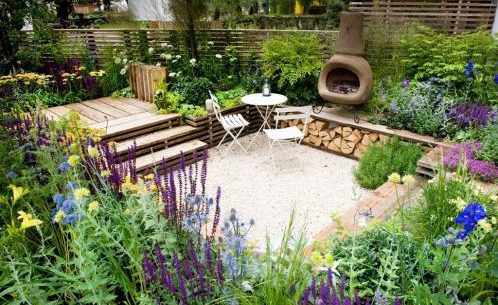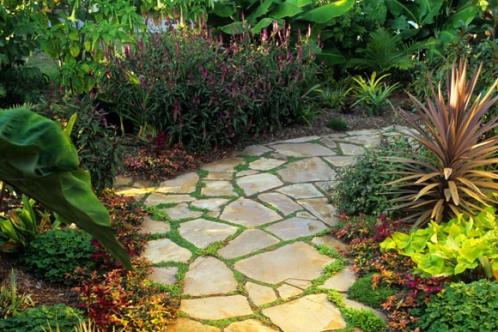
Exterior design
If your garden needs a rethink, it can pay to start from the ground up. These landscaping tips needn’t cost the earth
With Christmas on the horizon and times tough for many, the last thing you might feel like doing is spending money on your garden, but now that the planting is dying back and you can see its “bones”, it’s a good time to review what is there and what you can do to improve it. For some homeowners, the thought of having to maintain a garden the following year is just too much and they would rather Buy Synthetic Grass in Perth and have that installed instead. This is because artificial grass requires hardly any maintenance and looks good all year round. Of course, there are other homeowners who like the work and want to plant different plants each year. Whatever the choice or budget, there are three big potential costs before you even start thinking about the plants: the boundaries, the hard landscaping (terracing, paths, steps, internal walls) and labour. With a little planning and discipline, you can create something stylish.
Do it yourself
You can take inspiration from Mark Gregory, of the Surrey-based firm Landform, who created a low-budget garden at the Hampton Court Flower Show earlier in the year on a budget of 7,000. That may seem a lot at first, but if you think of a garden as an “outdoor room”, the costs are comparable to putting in a reasonably decent kitchen. Measuring 19ft x 29ft, it had a sunken gravelled seating area, two decks made of reclaimed scaffold boards, and steps connecting them. Labour accounted for nearly a third of the budget and Gregory advises doing much of the preparatory work yourself. “You can save money by digging out, filling skips, doing all the donkey work. Then get the landscapers in to do the more skilled work, such as building a wall or laying a stone terrace, where the detailing is important. If there’s a tree that needs removing because its branches are repeatedly falling, that’s also when you would need an expert in to help. It’s best to find tree removal service jacksonville fl based or similar for this type of work as it can be dangerous and needs to be done correctly.”
Boundaries
Walls are the priciest option, and unless you are an experienced DIYer, it’s probably advisable to have them professionally built. If you’re prepared to wait to get the kind of screening you want, then hedging is good value, and an ecologically sound choice to boot. If you buy bare-rooted plants in bulk, then a strip of green beech, for example, can cost less than 70 for 50 saplings (from Ashridge Trees; ashridgetrees.co.uk). These would make a 54ft single row or a 32ft double row. A similar length of wildlife-friendly mixed hedging from Hedge Nursery (hedgenursery.co.uk) costs from 42. Bare-rooted plants are delivered from November to March and, because they cost less to transport, are cheaper than container-grown specimens.
Another cheap screening idea is to use an open-weave material such as chain-link fencing – useful for long boundaries – and grow climbers up it. Prices start at about 30 for a 30ft roll; try meshdirect.co.uk. For contemporary gardens, panels of rusted steel rebar mesh, used in the construction industry to reinforce concrete, can make an affordable alternative. A sheet large enough to cover about 15ft of fencing costs about 45 from builders’ suppliers.

Crazy paving is cheaper than slabs (Marianne Majerus )
This was chosen as the main fencing in another of the budget gardens at Hampton Court, built by Arun Landscapes, based in West Sussex (arunlandscapes.co.uk). The mesh was cut into sections and sandwiched between two wooden uprights, erected to look like fence posts. “It doesn’t need maintenance or treating, is a perfect support for climbers and you can even cut viewing windows in it,” says the garden’s designer, Mike Harvey.
If you need to enclose the garden fully right from the start, then lapped fence panels are very economical. If you are concerned about ensuring the garden is fully enclosed, a friend of mine contacted ApexFenceCompany.com when renovating his garden and said they helped him with everything he needed. Most are dip-treated with preservative, and should last 7-10 years. Gregory advises looking at specialist fence suppliers rather than DIY stores: the panels they stock are more likely to be heavy-duty and pressure-treated, which should give them a longer life. Whichever you choose, invest in a few pots of paint to create a more stylish backdrop.
Hard landscaping
Lawns are still the cheapest way to clothe the garden, Gregory says, but for a small plot he finds them too time-consuming. Instead, he prefers to use low-maintenance gravel, planted with drought-tolerant species. Gravel ticks other boxes: it is permeable, and so helps prevent flooding, and if used with a honeycomb tray underneath, such as the Nidagravel system (nidagravel.co.uk), the pebbles shouldn’t drift around the place. Edge the area with bricks for a smart finish.
Scaffold boards are a low-cost option that gives a relaxed, industrial look; expect to pay between 3 and 5 for a 10ft board, from a local scaffolding contractor. Painted with a clear preservative, and resting on pressure-treated beams, this kind of decking should last at least seven years.
Stone is the most expensive option. If you’d really like a York stone terrace for your seating area, but can’t afford slabs, think about buying a job lot of irregular pieces and laying it like crazy paving. Reclamation yards often have supplies.
Plants
By choosing plants that are going to be happy in your soil and conditions, you’ll have fewer failures and so the money you do spend is not wasted. Think about including those with a long season – repeat-flowering roses; shrubs that produce blooms, autumn foliage and berries; and self-seeders you’ll be happy to see popping up throughout the garden.
If you’re not confident enough to make the choices yourself, it may save you money to ask a professional garden designer (see the directory at sgd.org.uk) to draw up a plan and to order in the plants, which they can buy at trade prices. Some garden centres also offer this service. If you need plants to form structure, spend some of your budget on a few key specimens at a decent size, especially trees and shrubs. Being patient, though, is the thriftiest tip of all.
[ssba]
